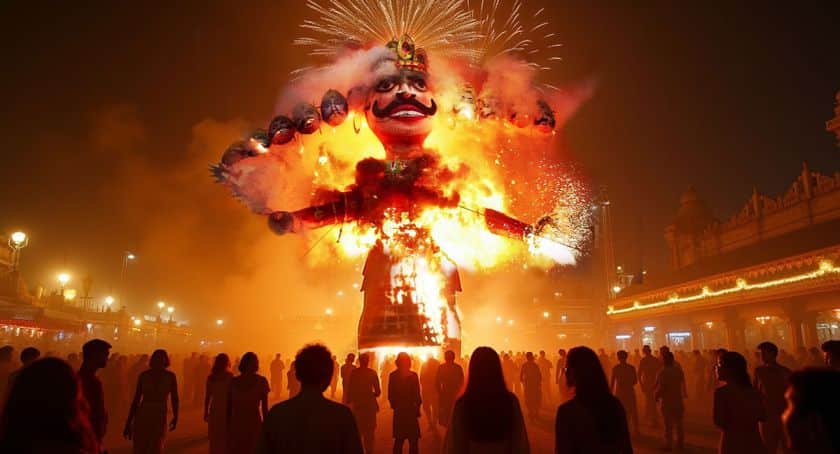The Grand Spectacle of Lankapodi Jatra
Odisha, a land steeped in mythology and vibrant traditions, is home to numerous festivals celebrating the state’s rich cultural and religious heritage. Lankapodi Jatra is a unique festival that reenacts the burning of Lanka, a significant event from the Hindu epic Ramayana. Held with great enthusiasm in Odisha’s Daspalla and Bisipada regions, this festival is an awe-inspiring blend of theatrical performance, religious devotion, and community spirit.
Mythological Roots of Lankapodi Jatra and Its Legendary Tale
The Lankapodi Jatra, which translates to ‘Burning of Lanka Festival,’ is rooted in the legendary tale of Lord Hanuman setting Lanka ablaze. This story comes from the Ramayana. Lord Hanuman, a devoted follower of Lord Rama, travels to Lanka in search of Goddess Sita, whom the demon king Ravana has abducted. Upon discovering her in Ashok Vatika, Hanuman creates chaos in Ravana’s kingdom. He ultimately sets Lanka on fire, using his burning tail as an act of divine justice.
Lankapodi Jatra, a grand festival that narrates the story and reinforces the values of truth, righteousness, and devotion, brings this dramatic moment to life.
When and Where is Lankapodi Jatra Celebrated?
Southern Odisha predominantly celebrates Lankapodi Jatra, with Berhampur, Chikiti, Aska, and Ganjam districts hosting significant festivities. People observe the festival during the Dussehra season, and on the concluding day, they traditionally burn Ravana’s effigy in many parts of India.
Unlike other Dussehra celebrations, which focus mainly on the victory of Lord Rama over Ravana, Lankapodi Jatra places Hanuman at the center of the action, making it a unique cultural phenomenon in Odisha.
The Grand Procession and Theatrical Performance
One of the highlights of Lankapodi Jatra is the massive procession and dramatic enactment of Hanuman’s journey to Lanka. The event unfolds in a series of well-orchestrated acts:
- The Entry of Hanuman: A performer, typically dressed as Hanuman, wears elaborate attire, applies face paint, and sports a long tail. During the festival, devotees consider the actor playing Hanuman a divine figure and offer their blessings.
- The Search for Sita: The enactment begins with Hanuman’s search for Goddess Sita in Ravana’s palace. Actors portraying demons and courtiers create a lively atmosphere, heightening the intensity of the performance.
- Confrontation with Ravana: One of the most exciting parts of the play is the moment when Hanuman is captured and presented before Ravana. The performers bring this mythological event to life with booming dialogue and dramatic expressions.
- The Burning of Lanka: The festival’s climax is burning an effigy or replica of Lanka. Using controlled fire effects and fireworks, the spectacle mesmerizes the audience and symbolizes the destruction of evil forces.
The Cultural and Religious Significance
Lankapodi Jatra is more than just an entertainment event; it is deeply rooted in cultural and religious beliefs. Some of its key significance includes:
- Devotional Fervor: Devotees believe that watching and participating in the Lankapodi Jatra brings them blessings from Lord Hanuman and Lord Rama.
- Victory of Good Over Evil: The burning of Lanka symbolizes the defeat of evil and the triumph of righteousness, aligning with the core values of Hindu philosophy.
- Preserving Folk Art and Theatre: This festival promotes traditional folk theatre and encourages the younger generation to stay connected to their cultural roots.
- Community Bonding: The event fosters unity and brings people together, reinforcing social harmony and collective joy.
Preparations and Community Involvement
The preparations for Lankapodi Jatra begin weeks in advance, involving multiple communities and artistic groups. Some of the crucial aspects include:
- Selection of Hanuman and Other Characters: Organizers assign the role of Hanuman to a skilled performer who undergoes rigorous training in expressions, acrobatics, and dialogue delivery.
- Making the Replica of Lanka: The artisans craft the effigy of Lanka using bamboo, paper, cloth, and flammable materials to ensure a dramatic yet safe burning event.
- Fireworks and Lighting Arrangements: The festival’s grand finale features colorful fireworks and pyrotechnics, making the experience visually spectacular.
- Chanting and Bhajans: Religious hymns and chants dedicated to Hanuman and Rama fill the event, enhancing the devotional ambiance.
The Modern Evolution of Lankapodi Jatra
In modern times, Lankapodi Jatra has evolved with modern influences while preserving its traditional essence. Some noticeable changes include:
- Use of Technology: Organizers have introduced LED screens, amplified sound systems, and digital effects to make the performance more engaging.
- Tourism and Popularity: The festival has gained national recognition, attracting tourists and cultural enthusiasts nationwide.
- Safety Measures: Authorities ensure better crowd management and fire safety to prevent mishaps during the burning ceremony.
Keeping the Tradition Alive
Lankapodi Jatra is not just an event but a living legend that continues to captivate and inspire generations. The combination of mythological storytelling, artistic brilliance, and community participation makes it an unforgettable experience. Whether you are a devotee, a culture lover, or a traveler, witnessing Lankapodi Jatra in Odisha offers a deep dive into India’s rich heritage. If you have the chance to visit Odisha during the Dussehra season, don’t miss the fiery spectacle of Lankapodi Jatra. It’s a celebration where devotion meets drama and history meets festivity!


